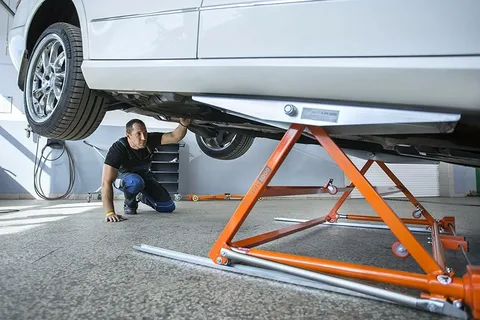Mobile tyre service professionals guide you on proper tyre maintenance and sudden tyre burst situations
What is the worst thing that can hit you while you are driving on the highway? More than anything else a sudden burst of tyre makes a motorist more vulnerable to risk and danger in such condition. Highways are meant to drive at higher speeds. While driving at higher speed if there is a tyre burst it definitely creates a life threatening condition. You cannot predict when your vehicle will suffer a tyre burst and take necessary precautions to keep you safe. So, what is the most obvious thing to do in such conditions? Obviously you have to learn and develop skills to handle the situation when a tyre suddenly goes bang while you are driving your automobile at higher speeds.
Tyre technology is steadily evolving and as such incidents of tyre burst are quite rare these days. But that does not give you room to relax while shutting your eyes to it. A tyre burst may occur anytime and anywhere and it can pretty much put a motorist in an uncomfortable, rather risky situation.
Handling a sudden tyre burst while driving at higher speeds
While your mind is concentrated on driving you may suddenly hear an explosion sound. There will be a whoosh in the air and the next thing that will follow the tyre will not be rolling anymore and rather flap over the road surface. When a tyre in the front blows out your vehicle is likely to sway either right or left; it depends on the tyre which has blown out. On the other hand if a rear tyre blows out the rear of the automobile sways back and forth.
Reasons that lead to tyre bursts
What triggers bursting of a tyre? There are several reasons that may cause a tyre to blow out or burst and one typical reason is the age. An aged tyre is more likely to blow out any moment opine professionals shouldering the responsibility of mobile tyre fitting in West London. In fact an aged tyre is always a potential risk even for the most skilled and experienced motorists. When proper tyre care is concerned the age of a tyre happens to be a crucial aspect in it.
Typical components in a tyre
What are tyres made up of? This question is absolutely relevant to the context we are dealing with. Tyres – in the modern times – are not made from any single component and rather are made up of as many as more than 200 individual components. The most significant components that go in the making or manufacturing procedure include rubber, silica and carbon black.
As time passes by these components and chemicals become degraded. Then after a point of time these components do remain soft and flexible enough and it is then the tyre becomes no more sufficient for proper usage. This is the way in which a tyre degrades or breaks down. Apart from the age factor another common reason that causes tyres to blow out is improper air pressure or more precisely to say under inflation.
Every tyre must be properly inflated to enable it to function smoothly and efficiently. What happens when a tyre is not inflated properly? It bulges out under the weight of the vehicle and this is bad for its health. A bulging tyre bounces up and down more than properly inflated ones especially while you are driving your automobile at higher speeds. This causes more friction and overheating of the tyre. As the tyre wears out faster, it also becomes more prone to blown outs.
Tyre bursts are more frequent in summers – why?
If you consider statics you will see that tyre blow outs are more common in summers than at any other time of the year. Now, there must be reason for it. In summers the atmosphere is more heated and this causes the internal pressure of tyres to rise. At a certain point of time internal pressure rises so high that both friction and the stress of a tyre increase to an unbearable level and that is when tyres blow out.
Experts who provide the service of mobile tyre fitting in West London explain this is the reason why tyre blow outs are more frequent in summers than any other time of the year. Actually several factors like hot weather, heavy loads, faster speeds and longer travelling, etc. combine together to raise the stress level of a tyre and as the stress level rises beyond capacity, the tyre blows out. As such all these factors come into play at the same time.
How to avoid tyre blow outs
Practically it is not feasible to avoid bursting or bowing out of tyres on every occasion. But you can definitely take precautionary steps to avoid bursting of tyres to a considerable level. Before setting out on a journey every time develop the habit of checking out tyres carefully. This will take about a minute or two at the most.
You should know the symptoms that are actually warning signs your tyres give out. While checking tyres you may even come across foreign objects like a nail clinging to the tyre surface. It is best to get your tyres thoroughly checked by an expert professional every six to eight months.
Tyres have a typical problem – they may appear healthy from outside although in reality they could be in a severely bad shape. Only a trained and skilled can actually decipher the actual condition of tyres and can equip you with accurate feedbacks. Proper maintenance and care help avoid tyre blow outs to a considerable extent.
Things to do while you experience a tyre blow out
While driving on the road if you experience a sudden tyre blow out these are the things you should do to avoid any untoward outcome.
- Slightly press on the race; this helps maintaining control over the vehicle to some extent
- Prioritise on driving straight; hold the steering firmly with both hands
- Gradually the car gets back into line and then release the race completely little at a time
- When the vehicle slows down enough apply minimum brakes bring it to a stop
- Your objective is to pull the vehicle off to the side of the road
- Ultimately you have to bring the vehicle to a complete stop by applying brakes
Last but nevertheless the least, professionals providing mobile tyre service in West London suggest, turn on the parking light and call a 24 hours mobile tyre mechanic for help.
visit for more blogs: How to Protect Different Surfaces during Jet Washing














1 comment